| If
this email is not displaying properly, please
follow this link |
 |
| EPICUREAN REFLECTIONS: |
| PAIRING FOOD & WINE |
| ALL THAT WINING AND DINING HAVE
NOT COME TO NOTHING (HOPEFULLY) |
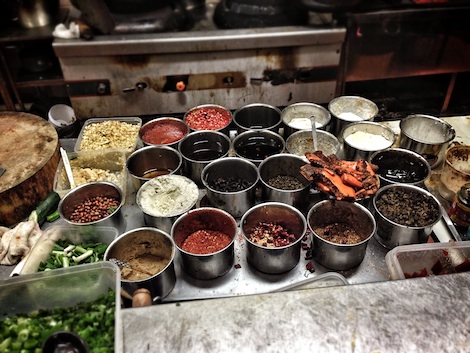 |
Dear friends, I had been so well nourished, especially in the last few months of 2013, that I am compelled to share this before the second part of "Major November" vinous recapitulation which I promise shall be in the next installment. Have a bountiful and beautiful 2014! Yours, Henry H. |
Having lived in
Southeast Asia, I am surrounded by a remarkably
diverse array of food. I don't know who taught me,
but I imbibe all quite happily.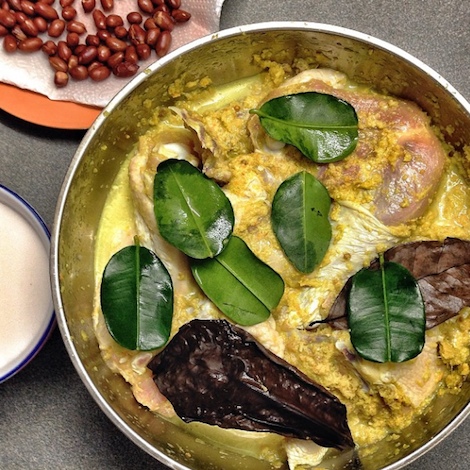 I
spent my adolescent years in Indonesia and my diet
naturally included local fare (mainly Javanese and
Padang,) as well as local Chinese food by the
streets or home cooked. Chilli and spices were de
rigeur, as was a smorgasbord of Chinese
ingredients which included fermented and cured
products, as well as a celebration of offal as
specialties. Even in those years, on special
occasions my mother would prepare classical Chinese
"treasures" such as sea cucumber, abalone and fish
maw, uniquely precious ingredients whose
appreciation is regrettably fading in the present
generation. I am glad that I know and love them well
for they teach me the idea of delicacy and
delicateness in a cuisine. I never thought these
much back then but they linger as some of the most
intensely delicious and complex flavours I have ever
tasted. I
spent my adolescent years in Indonesia and my diet
naturally included local fare (mainly Javanese and
Padang,) as well as local Chinese food by the
streets or home cooked. Chilli and spices were de
rigeur, as was a smorgasbord of Chinese
ingredients which included fermented and cured
products, as well as a celebration of offal as
specialties. Even in those years, on special
occasions my mother would prepare classical Chinese
"treasures" such as sea cucumber, abalone and fish
maw, uniquely precious ingredients whose
appreciation is regrettably fading in the present
generation. I am glad that I know and love them well
for they teach me the idea of delicacy and
delicateness in a cuisine. I never thought these
much back then but they linger as some of the most
intensely delicious and complex flavours I have ever
tasted.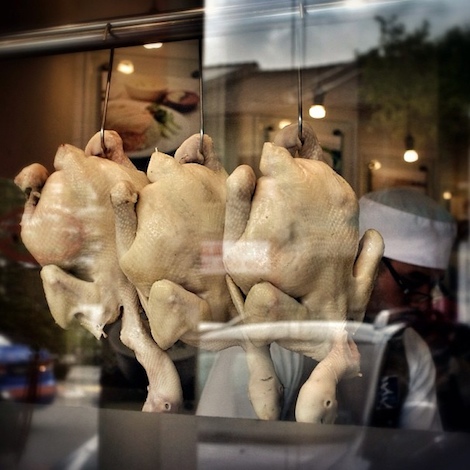 The
epicurean stimulation continued as I moved to
Singapore as a teenager. The local flavours are
kaleidoscopic as our eclectic cultures give birth to
bowls and plates of savoury deliciousness. Almost
everything is an assault to the senses. Even the
seemingly innocuous Hainanese chicken rice packs a
major flavour punch that is impossible to replicate
anywhere else. By now I know that Singaporeans eat
very well, but I was largely unaware of the magic of
my nourishment till much later in adulthood. What I
notice, however, is that I rarely complained about
my meals. Now that I think about it, this is a clue
to the quality of my eating life since my closest
friends are ever quick to remind that I am a very
picky eater indeed. The
epicurean stimulation continued as I moved to
Singapore as a teenager. The local flavours are
kaleidoscopic as our eclectic cultures give birth to
bowls and plates of savoury deliciousness. Almost
everything is an assault to the senses. Even the
seemingly innocuous Hainanese chicken rice packs a
major flavour punch that is impossible to replicate
anywhere else. By now I know that Singaporeans eat
very well, but I was largely unaware of the magic of
my nourishment till much later in adulthood. What I
notice, however, is that I rarely complained about
my meals. Now that I think about it, this is a clue
to the quality of my eating life since my closest
friends are ever quick to remind that I am a very
picky eater indeed.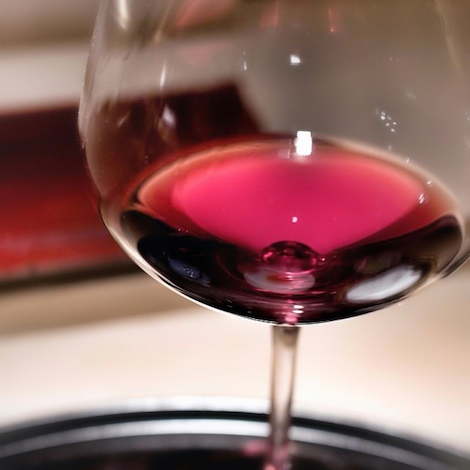 I
began dining out in restaurants more regularly as I
became interested in wine, if anything because it
was a matter of necessity. Our wine tastings were
mostly BYO (bring-your-own) in nature and finding
different places to dine is as essential as our
tasting discourses. Very quickly I found my penchant
for Japanese as well as various expressions of
provincial Chinese cuisine. Unsurprisingly we would
dine often at French and Italian establishments too
besides other gastronomy options, a luxury that only
a city like Singapore could host. I
began dining out in restaurants more regularly as I
became interested in wine, if anything because it
was a matter of necessity. Our wine tastings were
mostly BYO (bring-your-own) in nature and finding
different places to dine is as essential as our
tasting discourses. Very quickly I found my penchant
for Japanese as well as various expressions of
provincial Chinese cuisine. Unsurprisingly we would
dine often at French and Italian establishments too
besides other gastronomy options, a luxury that only
a city like Singapore could host.This was also about the time when I started paying closer attention to the nuances of each food culture. I learned to appreciate what makes each unique and how I might choose to make them work for my various moods. Although I am not a learned expert in these matters, I am a consummate food lover. I am also vexingly particular about what makes a meal truly great, an undertaking that is far more complex than merely a succession of one good dish after another. Having loved wine for so long, my dining habit has evolved into having wine with my meals daily. My passion for food is superseded only by my love for wine and so it is only natural that I am deeply invested in wanting them work together as complementarily and evocatively as possible. The subject of food and wine pairing has been extensively covered by many writers. While many of the proposed ideas deserve merits, I find they tend to rehash conventions founded on western dining precepts and thus conveniently ignores the unique features in our melting-pot food culture. For example, one must have heard these before: - serve wines that has residual sugar to counter spicier food - big bold red to pair with chunky roast meats - drink wine with high acidity to cut through fatty food - one is better off drinking beer with curry - the best pairing for foie gras is Sauternes Just to be clear, these are not irrelevant ideas. They do work, although sometimes I resent their cliché. They conveniently ignore a large flavour spectrum of our food, but the biggest deficiency of many popular pairing prescriptions is the disregard of texture in food, something that we Asians understand almost instinctively. When someone asks me how to pair a certain dish with wine, I will respond by probing further: Where would they dine (at home, fine-dining, casual restaurant, outdoor…)? Who are they dining with (business, casual, family, wine enthusiasts…)? How is the dish prepared (steamed, stir-fried, deep-fried, roasted, poached, low-temperature cooked, plain, sauced…)? What is the sauce base? What condiments would be served alongside? Although this may appear overbearing, in a normal conversation such exchange is natural and usually quite brief. When I can visualise the context, company and dishes, I can begin suggesting options. The process is more intuitive than prescriptive. I believe that pretty much any food I have eaten and will want to eat can be paired with wine. The choice of what wine might work with a particular dish is something not nearly as elusive as most people would imagine. What it requires, however, is an open mind (wine wise) as well as, yes, that spark of daring imagination. Most wine pairing advice is founded on the pairing of flavours. This is useful insofar as the food has a dominant taste profile. In our context where a dish may have a complex set of flavours melded together, the method presents a conundrum. Take a bowl of laksa as an example. How is one to unravel all the tastes to decide what wine would work best? |
| AVOID BORN ENEMIES |
| Let me try to list a
few antagonistic pairings as guidelines: - spicy hates oak and tannins - briny dislikes tannins - oily fish is sickened by oak - bitterness is disagreeable with new oak and high acidity Staying clear from these combinations help to narrow down the possibilities and prepare us for the next considerations. |
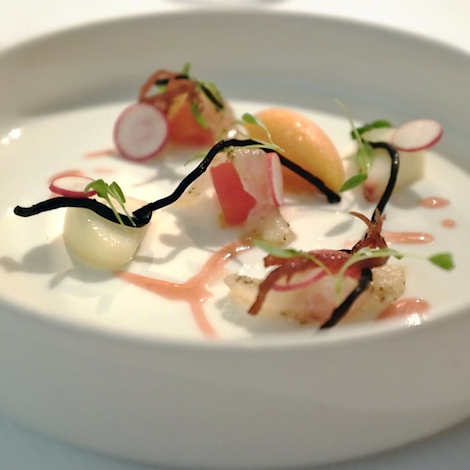 COLOUR |
| It may sound ludicrous
but I have found that matching dishes with wines of
similar colour is a very reliable, albeit general,
starting point. This simple guide is especially
useful when one is confounded with an unfamiliar
dish or a complex assembly of ingredients which
shares a certain gamut of colour. It seems intuitive
that pork chops should be paired with a hearty white
while soya-braised pork will be more at ease with a
medium-bodied red wine. Now if we use sushi as a
stage to illustrate this further, it should come as
no surprise that shiromi (white fleshed
fish) pairs better with delicate, crisp whites,
while akami (red fish, predominantly tuna)
is better accentuated with light-to-medium bodied
red wines. How about hikari-mono (silver
fish), gai (shellfish) and uni
(sea-urchin) then? Follow on as we discuss the next
considerations for food-wine matching. |
| ACIDITY |
| The discussion on
acidity of wine in the context of food-wine paring
tends to lean toward high-acidity wines. I am a
self-confessed acid freak. I mean, I love acidity.
Yet what I’ve found about (high) acidity and food is
that they don’t always work together optimally. In
fact, when it comes to white wines particularly,
lower-acidity white wines are far more useful on the
table than its sharper toothed brethrens. The key is
that the wine's acidity must be natural, so a blowsy
Chardonnay is not what I’m talking about here. A
Roussanne-based wine is amazing with nearly any kind
of food, even with spicier fares, as shall a Fino or
Manzanilla. But while a lower-acid white is useful,
when it comes to red wine, I find the higher-acidity
(and lower-tannin) variants more versatile on the
table. Here I turn to Pinot Noir often, and given
its diverse expressions depending on the region it
is grown as well as their styles, there are
different Pinots and/or burgundies for different
meals. One can construct a full-on degustation
pairing with just pinot noirs on the table. |
ALCOHOL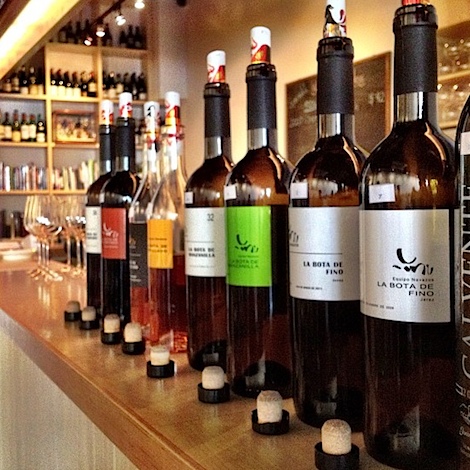 |
| Alcohol is the most
misunderstood and under-considered aspect of wine. I
appreciate low-alcohol and high-alcohol wines
equally as I find both useful for different
settings. People tend to squirm at high-alcohol
wines, calling them alcoholic and unbalanced even
before they taste it. This bias deserves correction.
A wine can be low or high in alcohol so long as it
is meant to be such in its natural state. Would you
want to drink a low-alcohol Amarone? Likewise I
would be alarmed at a Central Otago Pinot Noir at
12.5% alcohol too. Conversely, a Poulsard at 13.5%
is almost certain to be a Frankenstein of a wine.
The key here is balance, and naturalness. As much as
I find low-alcohol wines refreshing and easier to
drink, I also find higher-alcohol variants to be
endowed with generous textures useful for more
robust dishes, or lighter chewy dishes. We should
not shun alcohol but rather consider it as a feature
of wine that can make or break a pairing. |
| UMAMI |
| This savoury-sweet
taste so commonly found in everything we eat locally
and in Asian cuisine is so ubiquitous that we are
hardly conscious of its presence, yet we would
notice it immediately when it is absent. The fact
remains, however, that umami is all important for
imparting the feeling of well-being during a meal.
When working with a dish with noticeable umami, the
response is simple: pair with wines with umami
factor as well. Here we are generally talking about:
red Burgundy, northern Rhône Syrah, Poulsard,
Barolo/Barbaresco, Cabernet Franc from the Loire,
Savagnin from Jura, Sherry, white Burgundy, white
Rioja blend, and Alsatian Pinot Blanc and Riesling.
But which shall be paired with which? Here the
discussion on texture becomes important. |
TEXTURE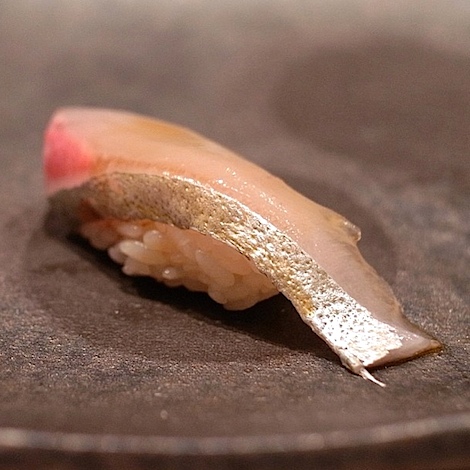 |
This is the single most
important precept I have learnt in my food-wine
pairing journey and it is a point I will gladly and
tirelessly repeat. In my books, textural
compatibility of food and wine is more useful as a
guide than flavour-profile matching. This point is
key when there is a diverse range of food flavours
in one single dish, a rather common situation in our
food culture.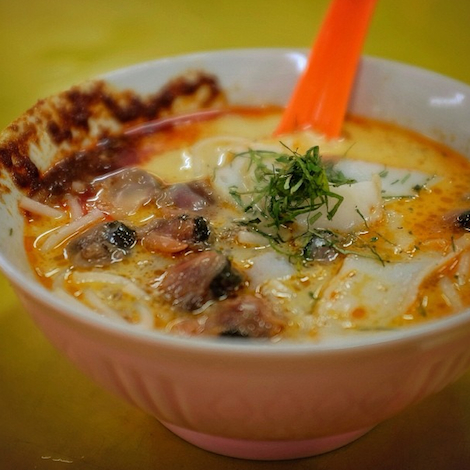 Let’s come back to my beloved
laksa. In this bowl one will find a sweet richness
of coconut milk, umami kick of dried shrimps, sharp
herbaciousness of the laksa leaves, the
metallic-sea-water taste of blood-cockles and the
spicy kick of the sambal paste. How does one begin
here? Tackling the taste one-by-one will necessitate
the deployment of several wines. Relating it to the
wine language, however, the dish can be simplified
into these key characteristics: umami,
medium-textured broth and spicy. The perfect pairing
I have found with this dish is a Manzanilla sherry.
Low in acid, yet crisp, full of umami and accented
by lime zest, this medium textured tipple deals with
laksa in ways that few other drinks could match: its
neutral-oak upbringing will not contradict the
spices; its salinity will complement the dish’s
umami profile; its elevated alcohol weaves into the
thickness of the broth and catalyses yet more umami
to emerge. Let’s come back to my beloved
laksa. In this bowl one will find a sweet richness
of coconut milk, umami kick of dried shrimps, sharp
herbaciousness of the laksa leaves, the
metallic-sea-water taste of blood-cockles and the
spicy kick of the sambal paste. How does one begin
here? Tackling the taste one-by-one will necessitate
the deployment of several wines. Relating it to the
wine language, however, the dish can be simplified
into these key characteristics: umami,
medium-textured broth and spicy. The perfect pairing
I have found with this dish is a Manzanilla sherry.
Low in acid, yet crisp, full of umami and accented
by lime zest, this medium textured tipple deals with
laksa in ways that few other drinks could match: its
neutral-oak upbringing will not contradict the
spices; its salinity will complement the dish’s
umami profile; its elevated alcohol weaves into the
thickness of the broth and catalyses yet more umami
to emerge.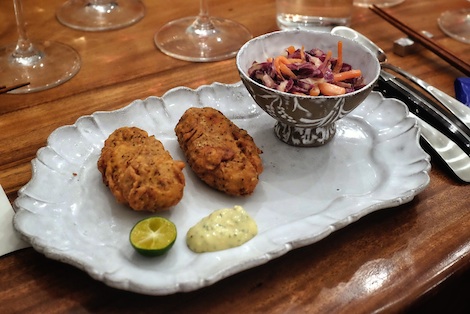 Let's
talk about a less esoteric example: fried chicken.
If one follows the principle of
acid-to-cut-into-grease and therefore picks up a
crisp white wine, the pairing may be effective, but
not necessarily delicious. Consider the texture and
profile of deep-fried meats and new options may
emerge. It is an oily-crisp chewy dish, the chicken
relatively neutral in aroma with the fragrance of
high-temperature frying. We want something that is
lively but medium textured here, with a bit of
fatness, compatible with the textural feel of fried
chicken. Oakiness is not a problem because the
buttery mouth-feel of the wine is texturally
compatible. I would be as happy to drink a young,
oaked New World Chardonnay, a generous Pinot Blanc
or a young dry white Rhône for its slightly oily
texture provided it is supported by good freshness.
Forgive the travesty to suggest that Chave's white
Hermitage will be insanely good with your fried
chicken wings. They truly work. Let's
talk about a less esoteric example: fried chicken.
If one follows the principle of
acid-to-cut-into-grease and therefore picks up a
crisp white wine, the pairing may be effective, but
not necessarily delicious. Consider the texture and
profile of deep-fried meats and new options may
emerge. It is an oily-crisp chewy dish, the chicken
relatively neutral in aroma with the fragrance of
high-temperature frying. We want something that is
lively but medium textured here, with a bit of
fatness, compatible with the textural feel of fried
chicken. Oakiness is not a problem because the
buttery mouth-feel of the wine is texturally
compatible. I would be as happy to drink a young,
oaked New World Chardonnay, a generous Pinot Blanc
or a young dry white Rhône for its slightly oily
texture provided it is supported by good freshness.
Forgive the travesty to suggest that Chave's white
Hermitage will be insanely good with your fried
chicken wings. They truly work.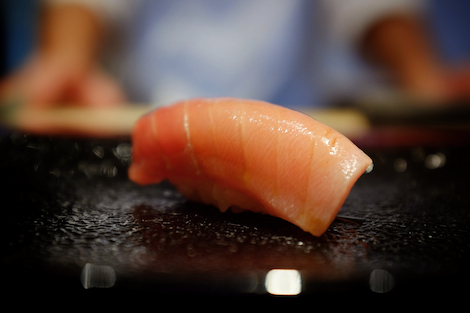 I
am partial to sushi, and herein I lay down my
general proposition for its pairing based on the
principal of textural compatibility. There is no
heavy dish in a concerto of sushi. Each course is
delicate, salty-sweet and mildly acidic thanks to
the seasoning in the rice as well as the nikiri
shoyu your itamae brushes on each piece. They are
full of umami too. While varying wildly in flavours,
the underlying texture of a nigiri sushi meal is
similar. It calls for brisk, medium bodied wines of
moderate-to-high acidity, rich in umami and
high-toned aromatics. Generally speaking, I have
found these to be delightful pairings with sushi:
Champagne (preferably drier side of Brut and better
with someone bottle age), red Burgundy, white
Burgundy, Poulsard, Cru Beaujolais, sherry (Fino,
Manzanilla and occasionally Amontillado), off-dry
Rieslings, dry/off-dry Loire Chenin Blancs,
oxidative Savagnin, and Vin Jaune or Château Chalon. I
am partial to sushi, and herein I lay down my
general proposition for its pairing based on the
principal of textural compatibility. There is no
heavy dish in a concerto of sushi. Each course is
delicate, salty-sweet and mildly acidic thanks to
the seasoning in the rice as well as the nikiri
shoyu your itamae brushes on each piece. They are
full of umami too. While varying wildly in flavours,
the underlying texture of a nigiri sushi meal is
similar. It calls for brisk, medium bodied wines of
moderate-to-high acidity, rich in umami and
high-toned aromatics. Generally speaking, I have
found these to be delightful pairings with sushi:
Champagne (preferably drier side of Brut and better
with someone bottle age), red Burgundy, white
Burgundy, Poulsard, Cru Beaujolais, sherry (Fino,
Manzanilla and occasionally Amontillado), off-dry
Rieslings, dry/off-dry Loire Chenin Blancs,
oxidative Savagnin, and Vin Jaune or Château Chalon.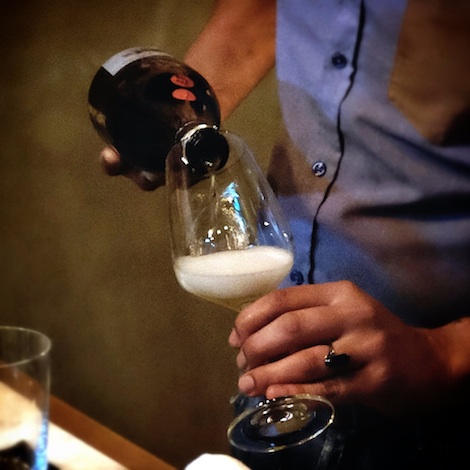 Were
I to bring only two wines to a sushi meal, I would
pick a vinous Champagne — to be served in a wine
glass — and a succulent red Burgundy. This
combination provides maximum versatility with
minimum fuss. The Champagne is gorgeous with white
and silver fishes, as well as a variety of
shellfish, while the Burgundy is perfect with sea
urchin, eel and tuna. At other times, I may
substitute Champagne with a Manzanilla and the red
Burgundy with a complex cru Beaujolais to achieve
similar pleasure. Were
I to bring only two wines to a sushi meal, I would
pick a vinous Champagne — to be served in a wine
glass — and a succulent red Burgundy. This
combination provides maximum versatility with
minimum fuss. The Champagne is gorgeous with white
and silver fishes, as well as a variety of
shellfish, while the Burgundy is perfect with sea
urchin, eel and tuna. At other times, I may
substitute Champagne with a Manzanilla and the red
Burgundy with a complex cru Beaujolais to achieve
similar pleasure. |
| FOOD-WINE, OR
WINE-FOOD? |
The common process of
enjoying food and wine together is this: eat the
food, followed by a sip of the wine. However, I have
found dramatically improved results when I reverse
this sequence. The effect is certainly different.
Taking a wine in first stimulates and perfumes the
olfactory in anticipation of receiving the flavours
and textures of food that is to come. The alcohol
and acid also open up the taste pores, whetting the
appetite for the next bite. It has stimulating
effect and, in certain situations, omit subtly
undesirable odours the dish may feature.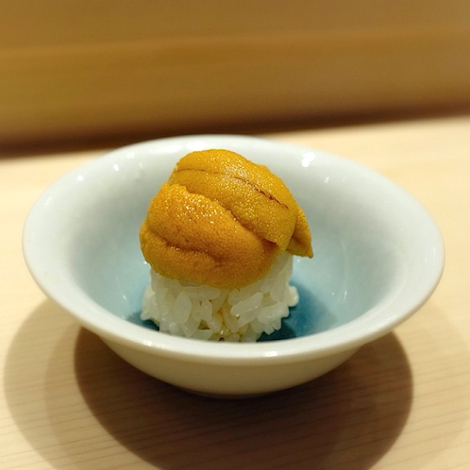 I have found that one of the
most shockingly great pairing is uni
(sea-urchin) with red Burgundy (preferably from the
Côte de Nuits sector where the tannins are finer).
It works admirably when the wine follows the uni,
but sipping the wine before popping in this gorgeous
morsel changes the game completely. The high-pitched
Pinot aromatics in the mouth remove the subtly musty
tone inherent in the uni shell while the
saline, berry-fruit coating the wine leaves in the
mouth multiplies the briny sweetness of the uni
the moment the latter pops in. Thus they explode
with great perfume and nectar-like sweetness. I have found that one of the
most shockingly great pairing is uni
(sea-urchin) with red Burgundy (preferably from the
Côte de Nuits sector where the tannins are finer).
It works admirably when the wine follows the uni,
but sipping the wine before popping in this gorgeous
morsel changes the game completely. The high-pitched
Pinot aromatics in the mouth remove the subtly musty
tone inherent in the uni shell while the
saline, berry-fruit coating the wine leaves in the
mouth multiplies the briny sweetness of the uni
the moment the latter pops in. Thus they explode
with great perfume and nectar-like sweetness.I have benefited from this reverse-order so much that I regularly sip my wine before chewing my food now. The wine seasons the palate to prepare for the flavours of the incoming food. The food is tastier, and there is no wash-away effect on the otherwise flavoursome bite that it was meant to accompany. |
| MORE OF THE SAME THING
IS JUST... BETTER |
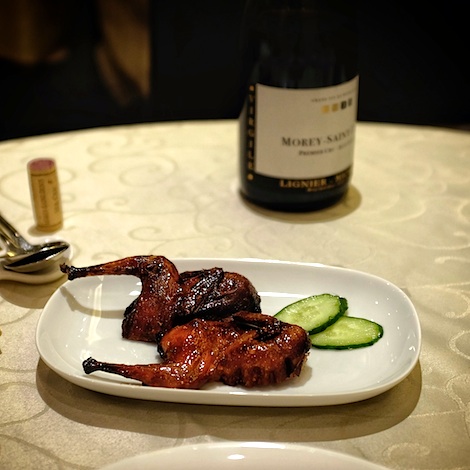 Umami
on umami, saline on salty, juicy on meaty, earthy on
gamey... Umami
on umami, saline on salty, juicy on meaty, earthy on
gamey...Putting wine and food that share similar defining characteristics rarely goes wrong. That component tends to magnify the same component in the other, not cancel it. This is where more is indeed more. (Well, except for sweet on sweet. That will be a tad much.) |
| SURPRISE YOUR DISH (AND YOURSELF) |
| We epicureans have
plenty of imagination, so we may as well use it. Foie
gras with a glass of Sauternes? Given that
this dish is normally served early in the meal, the
sticky richness of sweet wine may satiate the
appetite too early. On the other hand, pairing it
with an exuberant fruit-driven rosé Champagne works
beautifully and the juicy bubbly refreshes the taste
buds to anticipate more dishes to come. Another case
in point, sardines with a crisp white wine is not a
necessity either. This fish is meaty, full of umami
juiciness. Work it with a plump Beaujolais or
peppery Poulsard and watch them dance to a groovier
tune. |
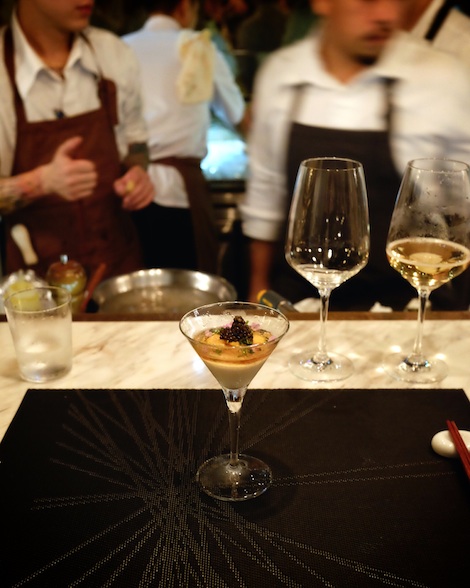 Choosing wines for a meal is neither an exact science nor mumbo jumbo voodooism. Rather it must be a creative undertaking motivated by and for the sake of personal pleasure. Some time ago in the long past, I did not think much about food-and-wine pairing: when I felt like a certain dish and a certain wine, I'd just put the two together. It did not work very well half the time, of course, but I have learnt from it since. Today I am more attentive to the nuances of my food and I know why I might feel like something today over other days. I accept now that our body responds to the subtle changes of our environment as much as it is cultured by our upbringing. We are as much intelligent as we are intuitive beings. So when it comes to choosing a wine for our meal, as much as we can endlessly mull it over trying to find the perfect match using every guideline we know of, we should never disregard what seems viscerally plausible. While these guides may turn a pairing from good to great, succumbing to that spark of imagination may transform it into something utterly delightful. It is a fun thing. So drink on, and play on. I know I would. |
| (To my love
who is oblivious to the fact that
she has a remarkable ability to discern and make
sense of complexity in food and wine.) |
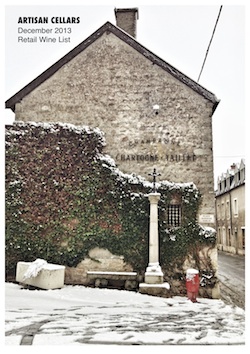 DOWNLOAD ARTISAN
CELLARS DOWNLOAD ARTISAN
CELLARS LATEST WINE LIST HERE >> Our latest retail catalog outlines the list of artisanal wines that we carry. We take pride in the sourcing and provenance of our wines, from the most affordable to the most prized. We are proud to work with the most respected growers from every wine region, each of them representing the very best that their respective appellation is capable of producing. Please write to sales@artisan-cellars.com or call us at +65 6838 0373 to inquire exact availability of wines, or to find out anything you wish to know about us and our wines. |
   390 Orchard Road B1-01 Palais Renaissance Singapore 238871 t +65 6838 0373 f +65 6836 0036 e sales@artisan-cellars.com w www.artisan-cellars.com |
| If you wish to be removed from our mailing list, please reply with the subject UNSUBSCRIBE |